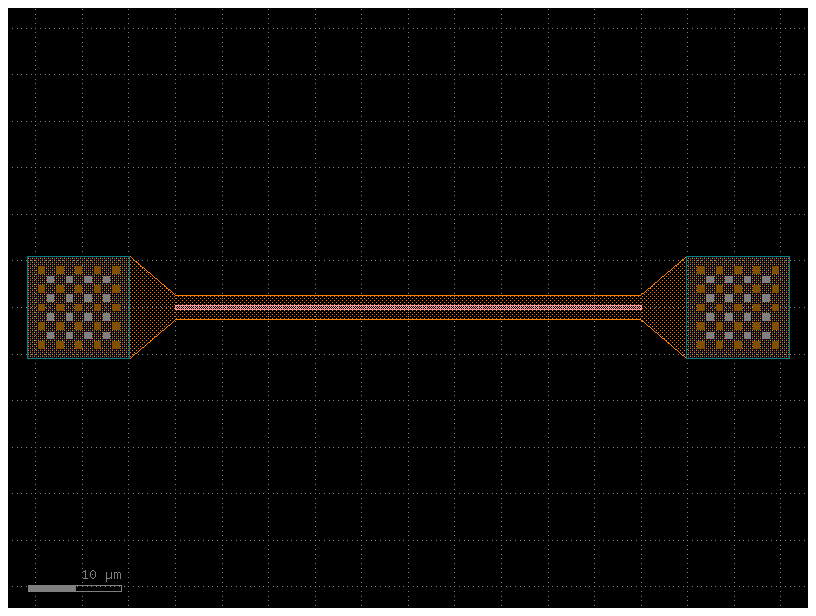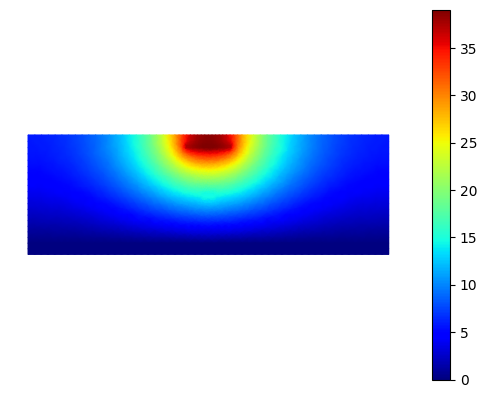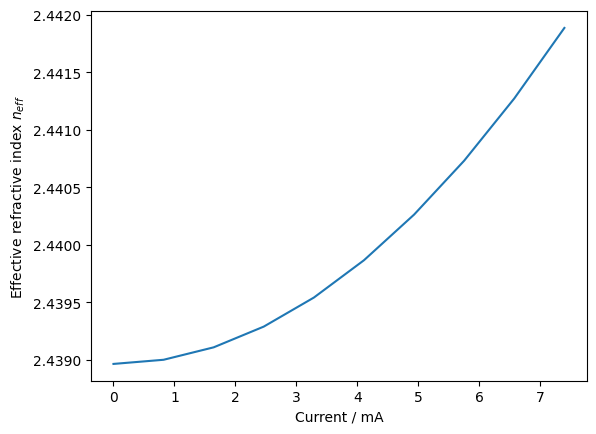Thermal#
You can use our FEM femwell plugin for thermal simulations. You can simulate directly the component layout and include important effects such as metal dummy fill.
import gdsfactory as gf
import meshio
from gdsfactory.generic_tech import get_generic_pdk
from gdsfactory.technology import LayerStack
from skfem.io import from_meshio
PDK = get_generic_pdk()
PDK.activate()
LAYER_STACK = PDK.layer_stack
LAYER_STACK.layers["heater"].thickness = 0.13
LAYER_STACK.layers["heater"].zmin = 2.2
heater = gf.components.straight_heater_metal(length=50)
heater.plot()

s = heater.to_3d()
s.show()
print(LAYER_STACK.layers.keys())
dict_keys(['substrate', 'box', 'core', 'shallow_etch', 'deep_etch', 'clad', 'slab150', 'slab90', 'nitride', 'ge', 'undercut', 'via_contact', 'metal1', 'heater', 'via1', 'metal2', 'via2', 'metal3'])
filtered_layer_stack = LayerStack(
layers={
k: gf.pdk.get_layer_stack().layers[k]
for k in ("slab90", "core", "via_contact", "heater")
}
)
from collections import OrderedDict
import matplotlib.pyplot as plt
import numpy as np
from femwell.maxwell.waveguide import compute_modes
from femwell.mesh import mesh_from_OrderedDict
from femwell.thermal import solve_thermal
from shapely.geometry import LineString, Polygon
from skfem import Basis, ElementTriP0
from skfem.io import from_meshio
from tqdm import tqdm
w_sim = 8 * 2
h_clad = 2.8
h_box = 2
w_core = 0.5
h_core = 0.22
h_heater = 0.14
w_heater = 2
offset_heater = 2 + (h_core + h_heater) / 2
h_silicon = 0.5
polygons = OrderedDict(
bottom=LineString(
[
(-w_sim / 2, -h_core / 2 - h_box - h_silicon),
(w_sim / 2, -h_core / 2 - h_box - h_silicon),
]
),
core=Polygon(
[
(-w_core / 2, -h_core / 2),
(-w_core / 2, h_core / 2),
(w_core / 2, h_core / 2),
(w_core / 2, -h_core / 2),
]
),
heater=Polygon(
[
(-w_heater / 2, -h_heater / 2 + offset_heater),
(-w_heater / 2, h_heater / 2 + offset_heater),
(w_heater / 2, h_heater / 2 + offset_heater),
(w_heater / 2, -h_heater / 2 + offset_heater),
]
),
clad=Polygon(
[
(-w_sim / 2, -h_core / 2),
(-w_sim / 2, -h_core / 2 + h_clad),
(w_sim / 2, -h_core / 2 + h_clad),
(w_sim / 2, -h_core / 2),
]
),
box=Polygon(
[
(-w_sim / 2, -h_core / 2),
(-w_sim / 2, -h_core / 2 - h_box),
(w_sim / 2, -h_core / 2 - h_box),
(w_sim / 2, -h_core / 2),
]
),
wafer=Polygon(
[
(-w_sim / 2, -h_core / 2 - h_box - h_silicon),
(-w_sim / 2, -h_core / 2 - h_box),
(w_sim / 2, -h_core / 2 - h_box),
(w_sim / 2, -h_core / 2 - h_box - h_silicon),
]
),
)
resolutions = dict(
core={"resolution": 0.04, "distance": 1},
clad={"resolution": 0.6, "distance": 1},
box={"resolution": 0.6, "distance": 1},
heater={"resolution": 0.1, "distance": 1},
)
mesh = from_meshio(
mesh_from_OrderedDict(polygons, resolutions, default_resolution_max=0.6)
)
mesh.draw().show()

And then we solve it!
currents = np.linspace(0.0, 7.4e-3, 10)
current_densities = currents / polygons["heater"].area
neffs = []
for current_density in tqdm(current_densities):
basis0 = Basis(mesh, ElementTriP0(), intorder=4)
thermal_conductivity_p0 = basis0.zeros()
for domain, value in {
"core": 90,
"box": 1.38,
"clad": 1.38,
"heater": 28,
"wafer": 148,
}.items():
thermal_conductivity_p0[basis0.get_dofs(elements=domain)] = value
thermal_conductivity_p0 *= 1e-12 # 1e-12 -> conversion from 1/m^2 -> 1/um^2
basis, temperature = solve_thermal(
basis0,
thermal_conductivity_p0,
specific_conductivity={"heater": 2.3e6},
current_densities={"heater": current_density},
fixed_boundaries={"bottom": 0},
)
if current_density == current_densities[-1]:
basis.plot(temperature, shading="gouraud", colorbar=True)
plt.show()
temperature0 = basis0.project(basis.interpolate(temperature))
epsilon = basis0.zeros() + (1.444 + 1.00e-5 * temperature0) ** 2
epsilon[basis0.get_dofs(elements="core")] = (
3.4777 + 1.86e-4 * temperature0[basis0.get_dofs(elements="core")]
) ** 2
# basis0.plot(epsilon, colorbar=True).show()
modes = compute_modes(basis0, epsilon, wavelength=1.55, num_modes=1, solver="scipy")
if current_density == current_densities[-1]:
modes[0].show(modes[0].E.real)
neffs.append(np.real(modes[0].n_eff))
print(f"Phase shift: {2 * np.pi / 1.55 * (neffs[-1] - neffs[0]) * 320}")
plt.xlabel("Current / mA")
plt.ylabel("Effective refractive index $n_{eff}$")
plt.plot(currents * 1e3, neffs)
plt.show()
0%| | 0/10 [00:00<?, ?it/s]
10%|█ | 1/10 [00:00<00:01, 4.67it/s]
20%|██ | 2/10 [00:00<00:01, 4.69it/s]
30%|███ | 3/10 [00:00<00:01, 4.70it/s]
40%|████ | 4/10 [00:00<00:01, 4.71it/s]
50%|█████ | 5/10 [00:01<00:01, 4.74it/s]
60%|██████ | 6/10 [00:01<00:00, 4.76it/s]
70%|███████ | 7/10 [00:01<00:00, 4.75it/s]
80%|████████ | 8/10 [00:01<00:00, 4.71it/s]
90%|█████████ | 9/10 [00:01<00:00, 4.72it/s]

/tmp/ipykernel_2733/3480375762.py:40: DeprecationWarning: The behavior of passing an array directly to `show` is deprecated and will be removed in the future. Use `plot` instead.
modes[0].show(modes[0].E.real)

100%|██████████| 10/10 [00:02<00:00, 2.70it/s]
100%|██████████| 10/10 [00:02<00:00, 3.80it/s]
Phase shift: 3.7863216387839405

